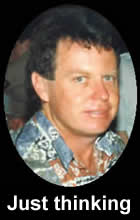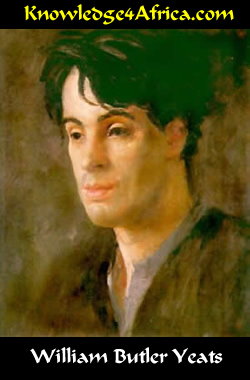|
READ THIS
The poem features Aengus, a hero from Irish mythology. One night, a maiden appears to him in a dream
or apparition, and Aengus thereafter travels for many years in search of her.
In the real myth, Aengus eventually finds her at the edge of a lake but she is under a spell and is being
forced to live a life as a swan. Aengus jumps into the lake after her and is also transformed into a swan.
Together they sing songs that are so beautiful that those who hear them are lulled to sleep. They live for
a year as swans before regaining their human shape.
"The Song of Wandering Aengus" takes the story at its very beginning, when Aengus meets the
maiden in his dream and then searches for her.
 ABOUT THE POET
ABOUT THE POET
William Butler Yeats was born in County Dublin (Ireland) in 1865, although the family soon relocated to
Sligo which the young poet came to think of as his spiritual home.
The family moved to England in 1876 so that their father could further his own career as an artist. At first
the young William was home-schooled and entered formal schooling only at the age of 12, where his
performance was described as mediocre.
When the poet was 15, however, the family returned to Dublin and it was here that he began writing
poetry, with his first works being published when he was about 17.
Yeats had a deep interest in mysticism, spiritualism, occultism and astrology, something that is reflected
in many of his poems. Indeed, his "Second Coming" cannot be understood unless this astrological
background is realised.
He was also involved in Irish nationalism, something too that is reflected in much of his writing.
In 1883 - when the poet was but 18 - he met Maud Gonne, then a 23 year old heiress. Their friendship
would last some 33 years.
By 1916, when Yeats was already 51 years old, he probably realised that chance of marriage with children
was passing him by. He suddenly became intent on having both and decided to propose to Maud Gonne
but she turned him down.
Two rumours arose out of this: first, that his poem "Wild Swans at Coole" was written after the
"shock" of his being turned down and, second, that Maud Gonne suggested he rather marry her
daughter, Iseult.
Probably neither story is true although marriage to the daughter had a greater chance of bearing offspring
than did the poet's marrying the mother.
It seems also likely that the proposal to Gonne herself was more a point of etiquette and that the poet
couched it with such conditions that refusal was the intention.
Yeats did then propose to the daughter but she likewise turned him down. Within months, however, the
poet married the 24 year-old Georgie Hyde-Lees with whom he had two children.
Yeats won several awards for his work, including the Nobel Prize for Literature in 1923. He died in France
in January 1939 at the age of 74.
Have you looked at the questions
in the right column?
|
TEST YOURSELF!
Read the left column and then answer
the following questions:
"It had become a glimmering girl
With apple blossom in her hair
Who called me by my name and ran
And faded through the brightening air."
- What was it that had become "a glimmering girl"? (2)

[Need help?]
The little silver trout had turned into the glimmering girl, hadn't it?
|
- How was it possible for that to happen? (2)

[Need help?]
This is a fantasy story, a fairytale. All things are therefore possible. In the werewolf stories, a person turns
into a wolf. In the story of Swan Lake, a young woman is turned into a swan. Here a fish turns into a
woman - and then vanishes.
|
- What was happening when she "faded through the brightening air"? (2)

[Need help?]
The woman has had a spell placed on her which turns her into a fish but, when caught, she turns back
into a young woman who will entice the young man to chase after her. She, however, vanishes into thin
air when she is pursued.
|
"Though I am old with wandering
Through hollow lands and hilly lands,
I will find out where she has gone,
And kiss her lips and take her hands."
- How do you know that Aengus has been searching for the woman for a very long
time? (2)

[Need help?]
The poem speaks of his being "old with wandering".
|
- Why does the poet speak of "hollow lands"? (4)

[Need help?]
The lands are literally full of hills and valleys. It is the valleys which are hollow. At the same time, the poet
wishes to convey the message that the valleys are also empty. In other words, he can't find the person
whom he is seeking.
|
- Does Aengus ever find her? (4)

[Need help?]
In this poem, Aengus has still not found her although he has not given up trying. In the real Irish myth,
however, he does eventually find her but she is a swan. He plunges into the lake after her, and he too
becomes a swan - and then the pair sing songs that are so beautiful that eventually the spell is broken.
|
"And pluck till time and times are done,
The silver apples of the moon,
The golden apples of the sun."
- Why the reference to plucking the silver and golden apples? (6)

[Need help?]
We are again caught up in the fantasy, aren't we. The apples are the magical fruit which are silver under
the moonlight but golden in the light of the sun.
Is there a reference here to the fruit in the Garden of Eden which the man and the woman were forbidden
to eat? Although the Bible doesn't say so, tradition has it that this fruit too was an apple.
There is probably also a sexual innuendo here: the rounded apples being the woman's rounded breasts.
In other words, Aengus will pluck her rounded apples or make love to her night and day for all eternity.
|
Comment on the colour imagery used in this poem. Why does the poet use these colours? (10)

[Need help?]
Several colours are used or are referred to in this poem: the colour of the fire, the white moths, the red
berry, the silver fish, the colour of the apple blossom, the golden grass, the silver and golden apples.
Bear in mind that in literature colours often have associations: white = innocense and purity; red = sexual
passion and sacrifice; silver and gold = wealth.
Do the colours have these meanings in this poem?
|
|



